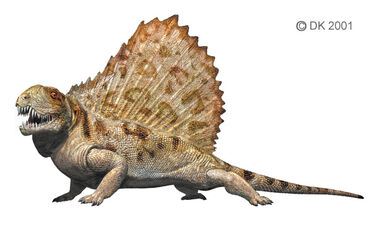Dimetrodon was a sail-backed, meat-eating animal that lived during the Permian Period, roughly 280 million year ago, long before the dinosaurs evolved. It was a so-called mammal-like reptile, an ancestor of the mammals.

Description[]
Dimetrodon was about 11.5 feet (3.5 m) long and weighed roughly 550 pounds (250 kg). It had a large sail-like flap of skin along its back, dense with blood vessels. The sail was supported by long, bony spines, each of which grew out of a separate spinal vertebra (a bone in the back). The sail may have been a thermoregulatory structure, used to absorb and release heat. The sail may have also been used for mating and dominance rituals, and/or for making it look much larger than it was to predators. Dimetrodon had sharp teeth and clawed feet.Dimetrodon was a dominant carnivore during the Permian period, living mainly in swampy areas. Unlike their fellow non-finned pelycosaurs, they warmed up early after sunrise, and cooled off more efficiently during the heat of the day. This efficient thermoregulation along with their large and powerful jaws gave them the advantage over their cohorts, making them dominant.Dimetrodon walked on four legs that sprawled out to the sides (unlike the dinosaurs, whose legs extended under their bodies). It was probably a very fast runner.
Dimetrodon appeared in the late Paleozoic Era, during the Permian period (about 280 million year ago), long before the dinosaurs evolved. Dimetrodon went extinct in the huge Permian extinction, 245 million years ago, which immediately preceded the Mesozoic Era.Dimetrodon probably sunned itself every day to raise its temperature and leave its cold, sluggish, night-time state. Its sail sped up this process enormously. It has been calculated that an average adult dimetrodon (weighing about 440 pounds = 200 kg) would take about 1 1/2 hours to raise its temperature from 79°C to 90°C (26°C to 32°C).Dimetrodon was a carnivore with a huge head and mouth, large, powerful jaws, and two types of teeth - sharp canines and shearing teeth. It probably ate other pelycosaurs (its close relatives), insects, and other animals. It could leave its cold, sluggish state much earlier after sunrise than the pelycosaurs with no sails (such as Archaeothyris, Casea, Ophiacodon, and Varanosaurus) and catch and eat them.Fossils of Dimetrodon have been found in Texas and Oklahoma in the USA. Trackways (fossilized footprints) of Dimetrodon have been found in Nova Scotia, Canada. Dimetrodon was named by paleontologist Edward Drinker Cope.